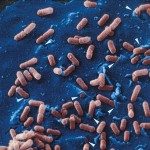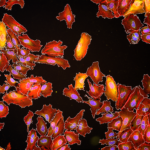Lien vers Pubmed [PMID] – 16362984
J. Pathol. 2006 Jan;208(2):215-23
Listeria monocytogenes is a Gram-positive bacterium that is able to invade and multiply within eukaryotic cells. Its intracellular life-cycle includes pathogen-induced phagocytosis, lysis of the phagocytic vacuole, movement in the cytoplasmic environment, and a cell-to-cell spread mechanism. Many L. monocytogenes virulence factors have been studied in detail, certain of which subvert specific eukaryotic cell functions in order to favour infection. During entry, the invasion protein InlA takes advantage of the adhesion molecule E-cadherin and the adherens junction machinery to adhere to target and invade polarized epithelial cells. Another invasion protein of the internalin family, InlB, subverts the signalling pathway of the hepatocyte growth factor receptor Met to induce endocytosis of the receptor and also to favour internalization of the bacteria in non-polarized epithelial cells. Once inside the cell, the haemolysin of L. monocytogenes–the listeriolysin O or LLO–is secreted to lyse the phagocytic vacuole, and when the bacteria is freed in the cytoplasm, the activity of the LLO is in part regulated by the infected cell itself, taking advantage of the pH sensitivity of the LLO that leads to its inactivation in the neutral eukaryotic cell cytoplasm. Finally, to induce bacterial movement in the cytoplasm, the L. monocytogenes surface protein ActA mimics the activity of the eukaryotic WASP family of proteins to recruit to the bacteria the actin nucleation machinery required for actin polymerization and for the formation of the actin structures (called ‘actin comet tails’) that propel the parasite in the cytosol and help it to invade neighbouring cells.



